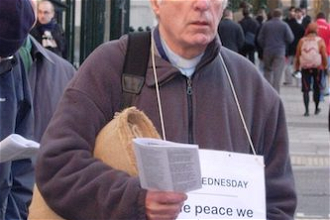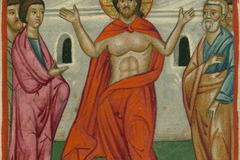David Alton reports from the Turkana Desert
During his recent visit to Southern Sudan as part of a Jubilee Action humanitarian mission, the independent Crossbench peer, David Alton, visited the frontline missionaries of St Paul. Imagine a diocese the size of Ireland and a parish where you can travel for most of two days without seeing another vehicle. This is the remote region of Turkana in Northern Kenya, close to the turbulent borders of Sudan, Kenya and Ethiopia. Turkana district comprises some 77,000 square kilometres and semi-desert where there is only very sparse vegetation. It has been described as "a sun-dried moonscape" and it is easy to see why. Famine and drought are a part of every day life for the Turkanas and death, suffering and endurance are words that need no explanation here. The young missionary priest who had invited Jubilee Action to see the work of his community had, one day earlier, buried seven of his parishioners shot dead by a raiding party who had come over the border to steal women and livestock. Death is no stranger in Turkana. During my recent visit I met the energetic and resourceful bishop, Patrick Harrington, an Irish priest of the Society of African Missions (SMA). As bishop of Lodwar (and only the second, having succeeded Bishop John Mahon) he is the only authority actively engaged in the provision of health, education and development initiatives. The government and aid agencies are nowhere to be seen. In his diocese 70 out of every 100 adults cannot read or write in an language; only about 15 of every 100 women are literate; more than 50% of children of school age do not attend school; and the infant mortality rate is 159 deaths for every 1000 live births. Last year the District Medical Officer said that the HIV/AIDS virus infects some 34% of the population. Before ending their relief operations in the area last month, World Vision reported that in the most recent famine (2000-2001) some two thirds of the people received food aid supplies. As the agencies move on to the next disaster zone it is difficult to see how they can conclude that the crisis is over in Turkana or to see what capacity they have left in place to equip the Turkanas to combat the next famine more effectively. Bishop Patrick has been a missionary all his life, and having served as Superior General of the SMA in Rome, he was asked to head up the diocese in 1995. He has a flock of about half a million Turkanas. Most follow traditional religions. About 20% are Catholic. He says, "Christianity is the one liberating force available to these people." During his episcopacy twelve new churches have opened, 10,000 people have been baptised and 5,000 others confirmed. I met one of the four Turkana priests who have been ordained and had the privilege of acting as witness for four young men as they received their minor orders in preparation for ordination next June. They will become part of a pastoral approach developed by the bishop and which seeks to spread the gospel message in word and deed. Bishop Harrington is fortunate to have a group of missionaries who have their motherhouse in Turkana. They run three of his parishes, covering a staggering area of about 30,000 square kilometres, and with each parish operating 10 to 12 outposts. The Missionary Community of St Paul the Apostle, and Mary Mother of the Church, was founded by a Spanish priest, Fr Francisco Andreo, who first came to Africa in 1968. He came to Turkana in 1982 and then, he says, "the desire to move to that region never left us." One of his priests, Fr Albert Salvans, is a priest of the Westminster diocese, an intriguing mixture of Spanish and adopted English, who was allowed to go to Turkana permanently by Cardinal Hume. He combines the role of priest, with that of engineer, medic and teacher. He even seems to run a mobile seminary in the back of his truck. I have never seen anyone change another burst tyre so quickly but a hundred miles from anywhere I did secretly wonder what happened next as the last spare was fitted to the truck. These Irish and Spanish missionaries follow in the relatively recent footsteps of the first missionaries to Turkana. During the colonial period the British did not permit access to what was a restricted area but famine in 1961 led to the first Catholic missionaries arriving here. Of course, other parts of Kenya have a long and sustained Christian presence. Kenya's great seaport of Mombassa reminds us that this was a cultural crossroads where Arab, Chinese, Portuguese, and Spanish sailors met. Today, there is still plenty to remind us of this period: Fort Jesus in Mombassa, built by Philip the II, the Vasco da Gama pillar, or the chapel that St Francis Xavier used to celebrate Mass during his stay in Malindi before departing to India. Even in the time of St Francis Xavier, the great Jesuit patron of the missions, the Christian travellers shared knowledge and expertise as well as the faith. Down to our own times, in the form of remarkable women like Mother Teresa of Calcutta, the Catholic approach has been to base evangelisation on this powerful combination of word and deed. In 1987 three women of the community of St Paul went to live in Loarengak, Turkana, in order to carry out a far-reaching health programme, covering more than 10, 000 sq. km. They organised a mobile clinic for the nomad population in fifteen different centres and a network of six primary health dispensaries. In the mobile clinics they make periodic checks on mothers and children up to 6 years of age. They have immunisation campaigns for children, and inform the mothers about questions related to basic hygiene and health. The desperate need to extend this provision was underlined to me in one graphic incident. Fr Albert was flagged down by some villagers to tell him that a young women was lying under a tree half a mile away choking on her own blood. She had miscarried two days earlier and was haemorrhaging. He lifted her into our truck and took her to the dispensary. Another young missionary then transferred her to his vehicle to drive her to the hospital at Lodwar - about five hours away. They have a rough airstrip but no plane. In this sort of situation it could have made the difference between life and death. In addition to dispensaries it is the Church who provides the education in Lodwar diocese - operating 97 primary and 6 secondary schools. The Missionaries of St Paul have also constructed many nursery schools. Since the beginning of 1993, the mission of Nariokotome has tried to be a place of initiatives in development projects that could improve people's lives long-term. This has included the practical formation of young aspirants to their community as well as vocational training for Turkana's young people. Carpentry, basic mechanics, and learning to work with metal form a basic vocational education. The goal is to make people self sufficient and not reliant on western handouts. I met a wonderful Kenyan called Frederick who has been working with the community on a range of horticultural and agricultural initiatives. With stunning success, and learning from the Israelis, they have made green barren tracts of land. Over the past decade they have dug wells, erected wind pumps, built dams and created irrigation projects - often with the help of young people from Britain, America, Spain and France. Today, hundreds of fruit trees grow at the mission together with vegetables, melons and watermelons - introducing the Turkanas, a nomadic people, to basic agriculture. They have also been developing fishing and bee keeping projects. It is now two years since the community started planting coconut and date palm-trees in the villages near the highly saline Lake Turkana. Planting trees has involved fencing the orchards from foraging animals. There is also more to be done in educating villagers about the necessity of the daily watering of the trees. Fr Albert took me to one of the rock catchments that the mission has built across small valleys that flood once or twice a year. Since they built their first dam at Nyiburin near the mission, more than five years ago, 14 more have followed. And four others are under construction. Each dam assures permanent water supply for around six hundred people and their livestock. Previously these people had to migrate to the areas bordering Sudan and Uganda during the dry season. With the help of two new excavators they have started building sand dams in the places where the absence of bedrock prevents the construction of rock catchments. Fr Albert says he desperately needs two Massey Ferguson tractors to get on with this work. Like the plane they need this is about life and death. The daily quest for drinking water for Turkana families is perhaps the most poignant sight you will see in Turkana. Women are crouched in the riverbeds scooping out sand trying to find water below. It is backbreaking work and these manual wells are always in danger of collapsing. When the rainy season comes and the women's water holes are covered in sand the process has to begin all over again. Perhaps the picture of water bringing life to the arid land is the best metaphor of all for these remarkable missionaries. Their water of life, through baptism and through development, brings the only hope in the lives of countless people. So what might we do to help? A parish in North London runs a small charity, New Ways that supports the work in Turkana. Bishop Harrington told me that he would like to twin his diocese with one in Britain. Why not put that to your own bishop? Parishes can twin too, perhaps taking on the building of a dam, a well, an irrigation project, a dispensary, a school or the pastoral support of the young men and women of this exciting and vibrant community. They also need volunteers - single and married - to commit themselves to working in the diocese, especially as catechists , teachers, and medics. And what else? On this Mission Sunday it is worth recalling what Fr Albert told the four men going forward for ordination next year. He reminded them of what Don Bosco's mother told him on the day of his ordination: "To become a priest is to begin to suffer." But the old Irish saying that where there is no pain there is no gain can comfort missionary priests. In Turkana the Missionaries of St Paul are standing at the centre of immense suffering and pain but they are making remarkable gains. It puts our own interminable introspective concerns into perspective. We are part of a universal church and these missionaries deserve our prayers and our practical support. You can write to Fr Albert Salvans at PO Box 49547, Nairobi, Kenya, or e-mail him at mcspa@form-net.com This article has been published on-line with permission of Lord Alton. It will be printed in The Catholic Times for Mission Sunday, October 20th 2002.


















